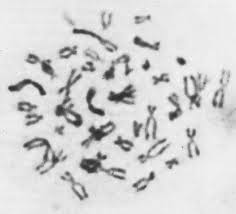Following the Human Genome Project, laboratory DNA testing has become fast, increasingly accurate and directly available to all of us. This form of genetic analysis is the future of diagnostic-led personalised medicine.
It does not get more personal.
Contents
- Correct Way for Family Genetic Testing
- Diagnostic-led Personalised Medicine
- Ensuring that New Tests are Clinically Meaningful
- Diagnostic v. Probability Information
- Genes - A Family Concern
- Getting Your Genes Tested
Process for Family Genetic Testing
The majority of family members with a family history of cancer will want to assess their own risk by having the latest genetic tests performed on themselves. However, there is a correct process and detecting the presence of a faulty gene may or may not be clinically diagnostic or immediately relevant. It is how the results from these tests are interpreted plus the clinical implications that need to be discussed and understood in detail both before and after testing.
I am a cancer physician, but I stopped giving chemotherapy drugs to patients a long time ago. I give patients information about genetic testing, about the advantages and disadvantages of looking for faulty genes in the family
Diagnostic-led Personalised Medicine
Genetic testing is the future of diagnostic-led medicine as it enables therapeutic approaches to be entirely personalised to the clinical requirements of the patient. Following the Human Genome Project, the latest genome technologies when handled by accredited laboratories can now rapidly detect genetic variations or 'faulty genes' in patients at a reduced cost and with high accuracy. This is creating a huge challenge for scientists, clinicians and policy makers because understanding the ramifications of what to do with the sheer amount of genome information is complex.
Genetic tests can detect variants in genes that have been identified with specific diseases or conditions. These tests also have non-clinical functions - such as the following:
- obtaining forensic evidence,
- migration or paternity testing.
For clinical purposes the tests can confirm the following:
- a suspected diagnosis,
- provide probability information on degree of risk,
- determine inherited predisposition to illness or
- predict effectivess of different drugs.
In the paediatric or obstetric setting the tests can also be used to screen for fertilisation or genetic defects.
Early genetic tests included looking at chromosome maps (karyotyping) to detect abnormalities such as Down's Syndrome and inherited disorders such as cystic fibrosis. Latest sequencing tests can identify risk for developing chronic diseases such as heart disease and cancer.
Ensuring that new tests are clincally meaningful
It is therefore critical to ensure that the process from research to clinical setting is managed by professionals who specialise in this area. Although genetic testing is becoming increasingly commonplace, mosts tests are still not regulated and can go to market without independent analysis to test the claims of the manufacturers. For example, the FDA in America has to date only regulated a small number of genetic tests sold to labs as diagnostic kits. This means that new tests have not always been examined to ensure that they are clinically meaningful. We are still therefore in a situation where the regulation is catching up with the science (and vice versa!) and this factor has to be taken into consideration when asking what tests can be perforrmed in the clinical setting.
See Video
Diagnostic v. Probability Information
Relatives of people who have had cancer may wish to be tested to see if they too carry faulty genes, especially the daughters of women who have had breast or ovarian cancer. However, prior to being tested, it is important to discuss the pros and cons because genetic testing does not necessarily bring certainty, but does bring alot more information - mostly 'probability-type' information.
We now know about many of the genes involved in cancer and can identify the faults in these genes. For example, the BRAC1 and BRAC2 genes associated with breast (and ovarian) cancer can have very subtle changes involving only one change in the sequence. Genes consist of individual sequences within the DNA of nucleotides made of nucleic acids including cytosine, adenine, guanine and thymine (CAGT). So, a gene is a short section of DNA and ech gene codes for a specific amino acid (building blocks of proteins) to be manufactured by the cell.
The BRAC gene consists of around 100,000 CAGTs and the change associated with cancer is just one single letter, which can happen anywhere in the length of the strand. As Consultant Clinical Genetic Oncologist, Dr James Mackay says, "This is a very subtle spelling mistake".
Ensuring high quality results from Genetic Testing - The need for Accurate BIOINFORMATICS
Genetic testing is still in its infancy and is subject to huge technical challenges, not least of all because of the sheer amount of information that is produced even from just a single sequence. Handling this level of data is a science in itself and is also prone to error. UK laboratory quality assurance systems are therefore stringent and insisting that labs offering these tests conform to ISO 15189 to ensure patient safety.
Demanding Quality, Accuracy and Consistency
Each lab may use a different manufacturer or protocol, especially for Next Generation Sequencing (NGS). Differing methods throw up completely different challenges for data analysis (bioinformatics) and there is therefore major variation in the quality of the results produced, which is a big source of concern. Doctors and patients thinking of using a laboratory should therefore insist on proof of quality accreditation, especially for the specific application of ISO 15189, and relevant bioinformatics processes on the test(s) in question.
A Family Concern
For anyone with a concern due to a family history there are two basic stages to genetic testing. Firstly the affected family member would be tested to see if they have a faulty gene, and then other people in the family can be tested. However, it is essential in all cases that people have accurate information on the limitations of this diagnostic approach, the accuracy of the clinical information, the likely outcomes, what the test will show and what they might decide to do about it.
Getting your Genes Tested
Latest genetic tests available from The London Breast Clinic can now analyse 25 genes from a single blood sample. Additional tests are also available such as the Endo Predict test which adds even further important information as it can help the breast cancer team to predict whether or not a patient will respond to hormone treatment alone - or whether they will also require chemotherapy.
Arrange an appointment for DNA Genetic Testing or speak to the clinic - click here




